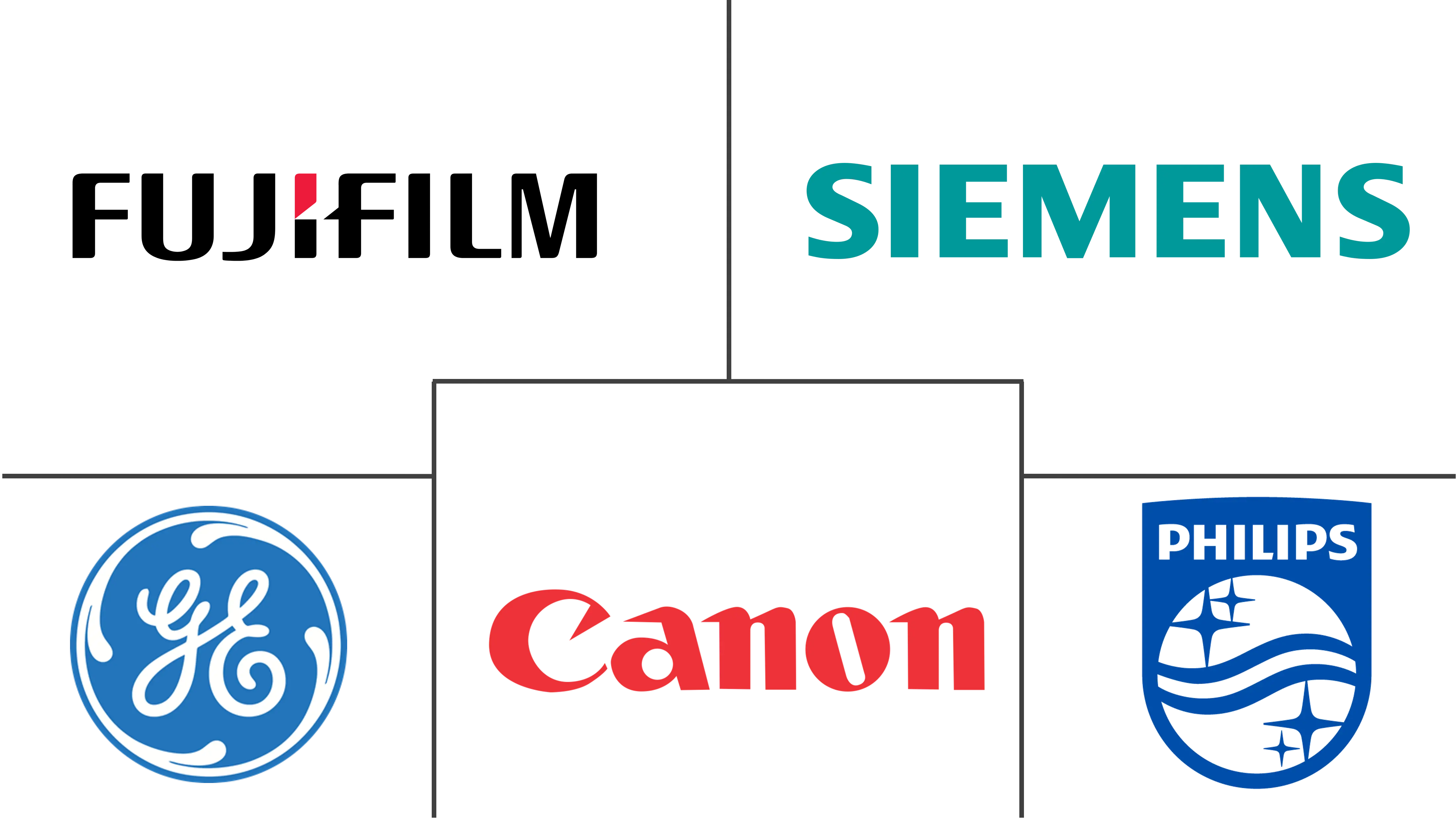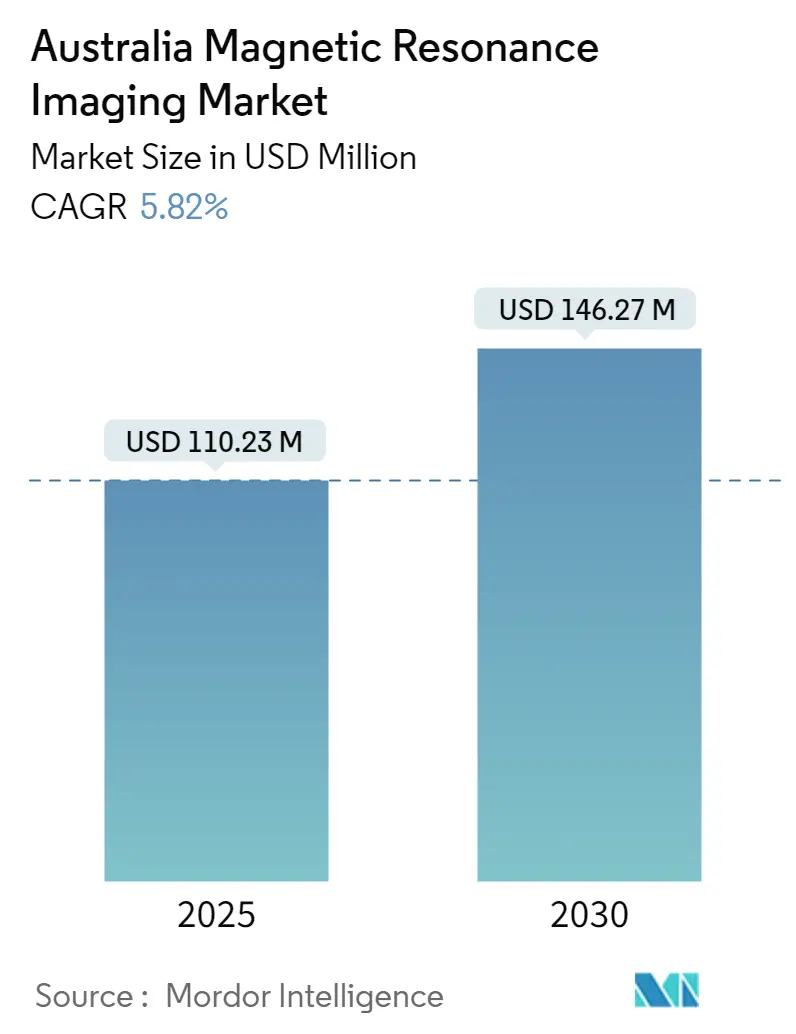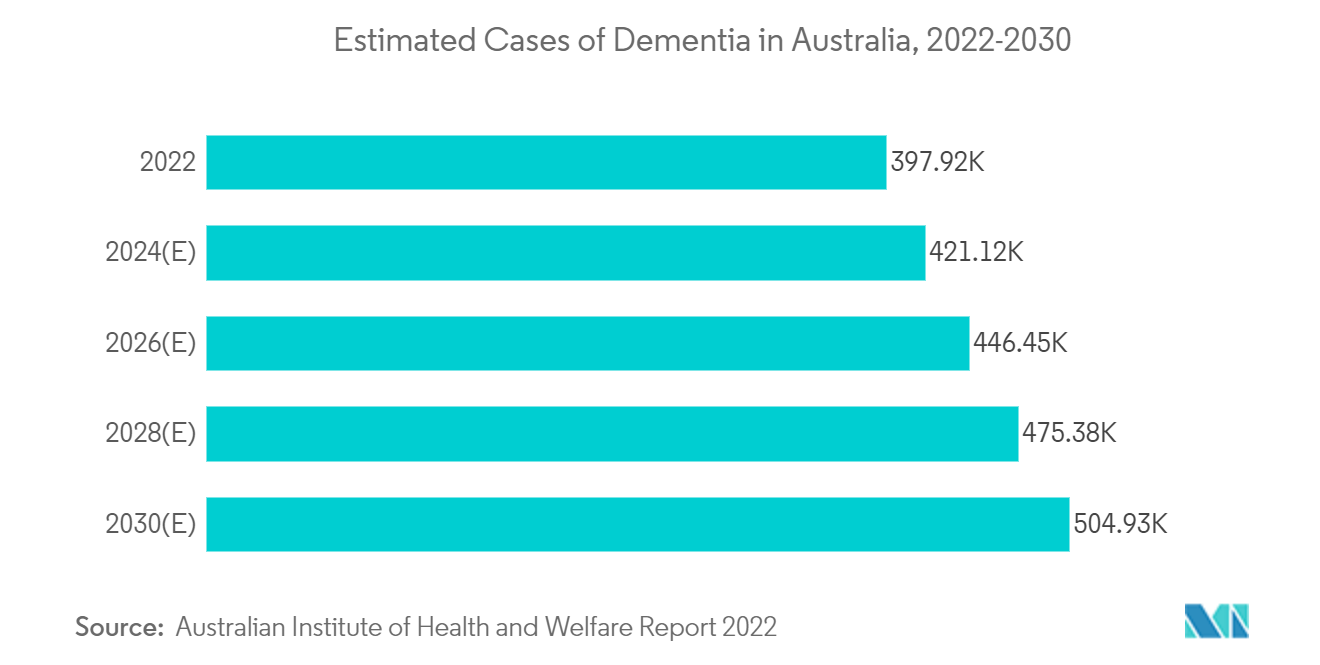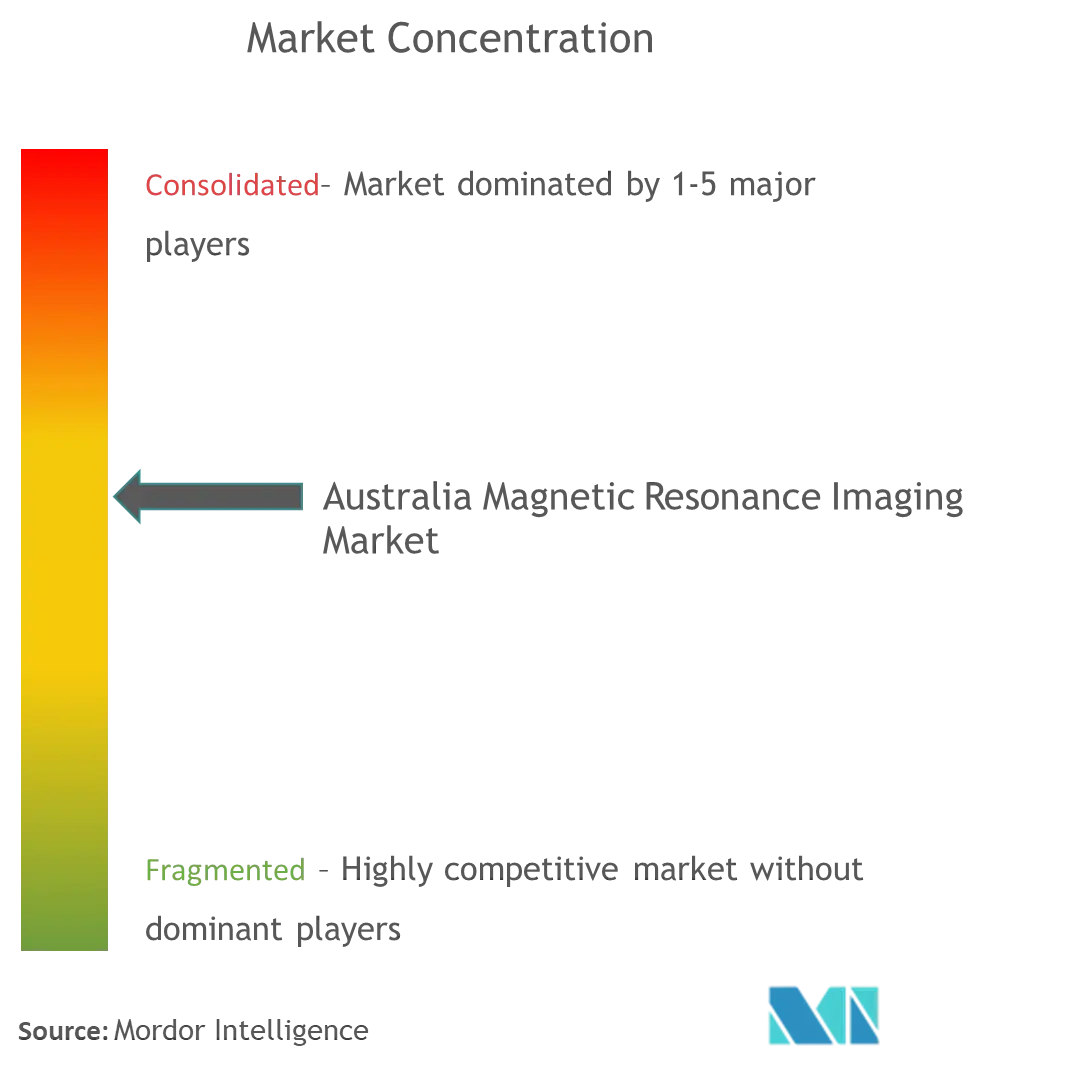Australia Magnetic Resonance Imaging Market Analysis
The Australia Magnetic Resonance Imaging Market size is estimated at USD 110.23 million in 2025, and is expected to reach USD 146.27 million by 2030, at a CAGR of 5.82% during the forecast period (2025-2030).
During the first wave of COVID-19 in Australia, there was a significant reduction in total diagnostic imaging services. This reduction in imaging services is mainly due to travel restrictions, closed hospitals and clinics, and others. A study published by the National Institute of Health in July 2021 was conducted to find the impact of the first wave of the COVID-19 pandemic on diagnostic imaging services in Australia using an interrupted time series model. Few services were impacted, such as MRI services, CT, and general radiography. But the services later, after releasing travel restrictions, observed a statistically significant increase in Imaging and CT services performed in the country. According to the Case Report published in frontiers in January 2021 titled 'Overlap Between Long COVID and Functional Neurological Disorders,' several complications associated with post-covid have been reported in Australia. COVID-19's neurological manifestations, such as changes in Posterior Reversible Leukoencephalopathy Syndrome (PRES), were on emergence. According to the article, this is Australia's first case of COVID-19 and PRES, which was detected using MRI brain imaging and confirmed clinically by the presence of disorientation, delirium, and headaches, as well as hypertension and blood pressure variability, and stable long-term kidney issues. For such conditions, the demand for MRI scanning has increased drastically in the country which is expected to fuel the market studied in Australia.
With the increasing burden of chronic diseases, such as cancer and cardiovascular diseases, on the healthcare system of Australia, coupled with the technological advancements in the country, the magnetic resonance imaging (MRI) market is expected to grow in Australia. According to the Globocan 2020 report, Australia reported 200,021 new cases of cancer in 2020, and the total number of five-year prevalent cases of cancer was 2,808,997, and further, the same report projected that the cases of cancer will reach 244,177 by 2030, and 284,785 by 2040, and with the rising prevalence of cancer in the country, the demand of MRI scanners is expected to increase for the detection and diagnostics of cases of cancer/tumor which will drive the growth of the studied market in the country.
Australia Magnetic Resonance Imaging Market Trends
Neurology is Expected to Witness Steady Growth Over the Forecast Period
Magnetic resonance imaging (MRI) of the brain produces high-quality two-dimensional or three-dimensional images of the brain and brainstem without the use of ionizing radiation or radioactive tracers.
According to Cancer Australia 2021, in Australia, 1,896 new cases of brain cancer were expected to be diagnosed (1,171 males and 725 females). By the age of 85, a person's risk of being diagnosed with brain cancer is estimated to be 1 in 161, with 1 in 130 for males and 1 in 211 for females. Furthermore, many developing countries are investing in these MRI machines for the betterment of people. This is fueling the demand for MRI systems. For instance, in July 2021, two MRI machines officially opened in Broken Hill with the aim of locals no longer needing to travel hundreds of kilometers to get scans. This hospital offers MRI diagnostic services for various neurological disorders.
Companies that are introducing new innovative technologies in the country are expected to increase segment growth. For example, in July 2021, in Australia, Omniscient Neurotechnology launched the 'Quicktome' Brain Mapping platform for neurosurgery after regulatory clearance in the United States, Canada, and Australia. A digital brain mapping platform that allows neurosurgeons to visualize and understand a patient's brain networks before performing life-changing brain surgery.
Thus, introducing innovative technologies in MRI along with the increased prevalence of various brain diseases is expected to boost the market in the country.
Australia Magnetic Resonance Imaging Industry Overview
The Australia magnetic resonance imaging market is highly competitive and consists of several major players. In terms of market share, a few of the major players currently dominate the market. However, with technological advancements and quality service provisions, mid-size to smaller companies are increasing their market presence by introducing new products at less prices. Companies, like Siemens Healthineers, GE Healthcare, Canon Medical Systems, and Philips Healthcare, hold a significant market share in the global magnetic resonance imaging market.
Australia Magnetic Resonance Imaging Market Leaders
-
Siemens AG
-
Canon Medical Systems
-
GE Healthcare
-
Fujifilm Holding Corporatio
-
Koninklijke Philips N.V.
- *Disclaimer: Major Players sorted in no particular order
Australia Magnetic Resonance Imaging Market News
- In March 2022, Siemens MRI Scanner was installed at North Eastern Community Hospital in the Benson Radiology department in South Australia.
- In April 2021, Philips installed cutting-edge digital imaging technologies at Westmead Hospital's new Central Acute Services Building in Sydney, Australia. The first Philips Magnetic Resonance, Ingenia MR-OR intraoperative devices have been installed in Australia and New Zealand, increasing the speed and efficiency of essential neuro cases.
Australia Magnetic Resonance Imaging Industry Segmentation
As per the scope of this report, magnetic resonance imaging is a medical imaging technique, which is used in radiology to produce pictures of the anatomy and the physiological processes of the body. These pictures are further used to diagnose and detect the presence of abnormalities in the body. Australia Magnetic Resonance Imaging (MRI) Market is segmented by Architecture (Closed MRI Systems and Open MRI Systems), Field Strength (Low Field MRI Systems, High Field MRI Systems, Very High Field MRI Systems and Ultra-high MRI Systems), Application (Oncology, Neurology, Cardiology, Gastroenterology, Musculoskeletal, and Other Applications). The report offers the value (in USD million) for the above segments.
| By Architecture | Closed MRI Systems |
| Open MRI Systems | |
| By Field Strength | Low Field MRI Systems |
| High Field MRI Systems | |
| Very High Field MRI Systems and Ultra-high MRI Systems | |
| By Application | Oncology |
| Neurology | |
| Cardiology | |
| Gastroenterology | |
| Musculoskeletal | |
| Other Applications |
Australia Magnetic Resonance Imaging Market Research FAQs
How big is the Australia Magnetic Resonance Imaging Market?
The Australia Magnetic Resonance Imaging Market size is expected to reach USD 110.23 million in 2025 and grow at a CAGR of 5.82% to reach USD 146.27 million by 2030.
What is the current Australia Magnetic Resonance Imaging Market size?
In 2025, the Australia Magnetic Resonance Imaging Market size is expected to reach USD 110.23 million.
Who are the key players in Australia Magnetic Resonance Imaging Market?
Siemens AG, Canon Medical Systems, GE Healthcare, Fujifilm Holding Corporatio and Koninklijke Philips N.V. are the major companies operating in the Australia Magnetic Resonance Imaging Market.
What years does this Australia Magnetic Resonance Imaging Market cover, and what was the market size in 2024?
In 2024, the Australia Magnetic Resonance Imaging Market size was estimated at USD 103.81 million. The report covers the Australia Magnetic Resonance Imaging Market historical market size for years: 2019, 2020, 2021, 2022, 2023 and 2024. The report also forecasts the Australia Magnetic Resonance Imaging Market size for years: 2025, 2026, 2027, 2028, 2029 and 2030.
Our Best Selling Reports
Australia Magnetic Resonance Imaging Industry Report
Statistics for the 2025 Australia Magnetic Resonance Imaging market share, size and revenue growth rate, created by Mordor Intelligence™ Industry Reports. Australia Magnetic Resonance Imaging analysis includes a market forecast outlook for 2025 to 2030 and historical overview. Get a sample of this industry analysis as a free report PDF download.






